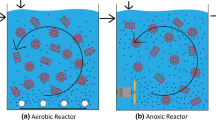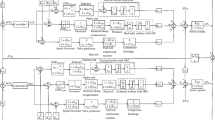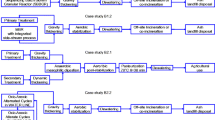Abstract
Wastewater treatment systems have recently taken on new trends resulting from the growing awareness of health and environmental risks. New strategies aimed at the recovery of treated water are increasingly being proposed. Given its better performance, biological treatment via an activated sludge process (ASP) represents the key phase in the overall treatment chain. In this work, a Takagi–Sugeno (TS) fuzzy-based modeling and control approach of an ASP is proposed and successfully carried out for the carbon removal. Using the formalism of linear parameter-varying state-space representation and convex polytopic transformation, a TS fuzzy model of the studied ASP is firstly established. Such a fuzzy model is then used to design advanced control laws that maintain the considered state variables, i.e., volume of the effluent and concentrations of the heterotrophic biomass, biodegradable substrate and dissolved oxygen, at the set-point values. Two stabilization control approaches, namely parallel distributed compensation and static output parallel distributed compensation, are proposed and successfully applied. All these control problems are reformulated as Lyapunov quadratic stability conditions and linear matrix inequality constraints. Demonstrative results are carried out and compared to show the effectiveness and superiority of the proposed TS fuzzy-based control approach of such complex and nonlinear biochemical processes.





















Similar content being viewed by others
Availability of data and materials
No data and materials available.
Code availability
No code is available but instructions for modeling and control implementation can be requested by email from the corresponding author.
References
Crites RW, Middlebrooks J, Bastian RK, Reed SC (2014) Natural wastewater treatment systems. CRC Press, New York
Olsson G, Newell B (1999) Wastewater treatment systems: modelling, diagnosis and control. IWA Publishing, London
Van Haandel AC, Van der Lubbe JGM (2012) Handbook of biological wastewater treatment design and optimization of activated sludge systems. IWA Publishing, London
Ballhysa N, Kim S, Byeon S (2020) Wastewater treatment plant control strategies. Int J Adv Smart Converg 9:16–25
Lahdhiri A, Lesage G, Hannachi A, Heran V (2020) Steady-state methodology for activated sludge model 1 (ASM1) state variable calculation in MBR. Water. https://doi.org/10.3390/w12113220
Gernaey KV, Van Loosdrecht MCM, Henze M, Lind M, Jørgensen SB (2004) Activated sludge wastewater treatment plant modelling and simulation: state of the art. Environ Model Softw 19:763–783
Lefebvre B (ed) (2019) The activated sludge process: methods and recent developments. Nova Science Publishers, New York
Wesley Eckenfelder W, Grau P (1998) Activated sludge process design and control: theory and practice. CRC Press, New York
Huang S, Zhang L, Guo H, Chen P, Xia W, Hu C (2019) Modeling and optimization of the activated sludge process. In: 38th Chinese control conference, Guangzhou, China, 27-30 July 2019, pp 6481–6486
Gujer W, Henze M, Loosdrecht M, Mino T (1999) Activated sludge model no.3. Water Sci Technol 39:183–193
Henze M, Gujer W, Mino T, Matsuo T, Wetzel M, Marais GR (1994) Activated sludge model no. 2, Technical Report. IAWQ, London, UK
Henze M, Leslie Grady CP, Gujer W, Marais GR, Matsuo T (1987) Activated sludge model no.1, Technical Report. IAWQ, London, UK
Rizwan Azhar M, Emadadeen A (2014) Advanced control strategy for wastewater treatment process: a parametric study. Int J Chem Eng Appl 5:335–341
Weijers S (2000) Modelling, identification and control of activated sludge plants for nitrogen removal. PhD dissertation, Technische Universiteit Eindhoven, Pays Bas
Du X, Wang J, Jegatheesan V, Shi G (2018) Dissolved oxygen control in activated sludge process using a neural network-based adaptive PID algorithm. Appl Sci. https://doi.org/10.3390/app8020261
Georgieva PG, Feyo de Azevedo S (1999) Robust control design of an activated sludge process. Int J Robust Nonlinear Syst 9:949–967
Chakravarty SP, Roy A, Roy P (2022) Control of activated sludge treatment process using pre-compensated multi-variable quantitative feedback theory-based controller. Trans Inst Measur Control 44:506–522. https://doi.org/10.1177/01423312211039048
Debel Hansen L, Veng M, Durdevic P (2021) Compressor scheduling and pressure control for an alternating aeration activated sludge process: a simulation study validated on plant data. Water 13(8):1037. https://doi.org/10.3390/w13081037
Revollar S, Vilanova R, Vega P, Francisco M, Meneses M (2020) Wastewater treatment plant operation: simple control schemes with a holistic perspective. Sustainability 12(3):768. https://doi.org/10.3390/su12030768
Revollar S, Vilanova R, Francisco M, Vega P (2018) PI dissolved oxygen control in wastewater treatment plants for plant wide nitrogen removal efficiency. IFAC-PapersOnLine 51:450–455
Revollar S, Vega P, Vilanova R, Francisco M (2017) Optimal control of wastewater treatment plants using economic-oriented model predictive dynamic strategies. Appl Sci 7(8):813. https://doi.org/10.3390/app7080813
Petre E, Selișteanu D, Șulea-Iorgulescu C, Mehedințeanu S (2019) Mathematical modeling and control for an activated sludge process in a wastewater treatment plant. In: 20th International Carpathian control conference, Krakow-Wieliczka, Poland, 26–29 May 2019, pp 1–6
Xie YB, Wang D, Qiao JF (2022) Dynamic multi-objective intelligent optimal control toward wastewater treatment processes. Sci China Technol Sci 65:569–580. https://doi.org/10.1007/s11431-021-1960-7
Takagi T, Sugeno M (1985) Fuzzy identification of systems and its application to modeling and control. IEEE Trans Syst Man Cybern 15:166–172
Tanaka K, Wang HO (2001) Fuzzy control systems design and analysis: a linear matrix inequality approach. Wiley, New York
Sayadian N, Jahangiri F, Abedi M (2024) Adaptive event-triggered fuzzy MPC for unknown networked IT-2 T-S fuzzy systems. Int J Dyn Control. https://doi.org/10.1007/s40435-023-01360-w
Taghieh A, Mohammadzadeh A, Zhang C, Kausar N, Castillo O (2022) A type-3 fuzzy control for current sharing and voltage balancing in microgrids. Appl Soft Comput 129:109636. https://doi.org/10.1016/j.asoc.2022.109636
Taghieh A, Zhang C, Alattas KA, Bouteraa Y, Rathinasamy S, Mohammadzadeh A (2022) A predictive type-3 fuzzy control for under- actuated surface vehicles. Ocean Eng 266(4):113014. https://doi.org/10.1016/j.oceaneng.2022.113014
Freitas JBS, Marquezan L, de Oliveira Evald PJD, Peñaloza EAG, Hernandez Cely MM (2024) A fuzzy-based predictive PID for DC motor speed control. Int J Dyn Control. https://doi.org/10.1007/s40435-023-01368-2
Qiao Y, Wang K (2023) Fuzzy sliding mode speed control strategy of permanent magnet motor under variable load condition. Int J Dyn Control. https://doi.org/10.1007/s40435-023-01285-4
Yang T, Qiu W, Ma Y, Chadli M, Zhang L (2014) Fuzzy model-based predictive control of dissolved oxygen in activated sludge processes. Neurocomputing 136:88–95
Abdul Gaffar S, Murali Mohan S, Seshagiri Rao A (2021) Fuzzy logic control of active sludge-based wastewater treatment plants. In: Karri RR, Ravindran G, Dehghani MH (eds) Soft computing techniques in solid waste and wastewater management, Chapter 25. Elsevier, pp 409–422
Chadli M, Maquin D, Ragot J (2000) Relaxed stability conditions for Takagi-Sugeno fuzzy systems. In: IEEE international conference on systems, man and cybernetics, Nashville, TN, USA, 08–11 October 2000, pp 3514–3519
Boyd S, El Ghaoui L, Feron E, Balakrishnan V (1994) Linear matrix inequalities in system and control theory. Society for Industrial and Applied Mathematics, Philadelphia
Taghieh A, Mohammadzadeh A, Tavoosi J, Mobayen S, Rojsiraphisal T, Asad JH, Zhilenkov A (2021) Observer-based control for nonlinear time-delayed asynchronously switching systems: a new LMI approach. Mathematics 9(22):2968. https://doi.org/10.3390/math9222968
Taghieh A, Shafiei MH (2021) Static output feedback control of switched nonlinear systems with time-varying delay and parametric uncertainties under asynchronous switching. Trans Inst Meas Control 43(5):1156–1167
Khallouq A, Karama A, Abyad M (2021) Observer based robust H∞ fuzzy tracking control: application to an activated sludge process. PeerJ Comput Sci 7:1–22. https://doi.org/10.7717/peerj-cs.458
Matoug L, Khadir MT (2017) Comparison between GPC and adaptive GPC based on Takagi Sugeno multi-model for an activated sludge reactor. Control Cybern 46(2):147–176
Nagy AM, Mourot G, Marx B, Ragot J, Schutz G (2010) Systematic multi-modeling methodology applied to an activated sludge reactor model. Ind Eng Chem Res 49:2790–2799
Nagy AM, Marx B, Mourot G, Schutz G, Ragot J (2011) Observers design for uncertain Takagi-Sugeno systems with unmeasurable premise variables and unknown inputs: application to a wastewater treatment plant. J Process Control 21(7):1105–1114
Dhouibi S, Jarray R, Bouallègue S (2023) Modelling and control of wastewater treatment systems: Case of activated sludge processes. In: 9th international conference on green energy and environmental engineering, Sousse, Tunisia, April 28–30, 2023
Dhouibi S, Bouallègue S (2022) Modeling and control design of an activated sludge process: A Multi-model approach. In: 21st IEEE international conference on sciences and techniques of automatic control and computer engineering, Sousse, Tunisia, December 19–21, 2022
Chadli M, Maquin D, Ragot J (2002) An LMI formulation for output feedback stabilization in multiple model approach. In: 41st IEEE conference on decision and control, Las Vegas Nevada, USA, pp 311–316
Yoneyama J, Nishikawa M, Katayama H, Ichikawa A (2000) Output stabilization of Takagi-Sugeno fuzzy systems. Fuzzy Sets Syst 111(2):253–266
Acknowledgements
Authors would like to thank the reviewers for their valuable comments and suggestions which helped to improve the scientific quality of the manuscript.
Funding
No funding was received to assist with the preparation of this manuscript.
Author information
Authors and Affiliations
Contributions
Conceptualization was performed by AA and SB; methodology was done by SB; formal analysis and investigation were conducted by SB; writing–original draft preparation was revised by AA; writing–review and editing were prepared by SB; resources were provided by AA; supervision was carried out by SB.
Corresponding author
Ethics declarations
Conflict of interest
No conflicts of interest associated with this publication. Authors have no relevant financial or non-financial interests to disclose.
Rights and permissions
Springer Nature or its licensor (e.g. a society or other partner) holds exclusive rights to this article under a publishing agreement with the author(s) or other rightsholder(s); author self-archiving of the accepted manuscript version of this article is solely governed by the terms of such publishing agreement and applicable law.
About this article
Cite this article
Arifi, A., Bouallègue, S. Takagi–Sugeno fuzzy-based approach for modeling and control of an activated sludge process. Int. J. Dynam. Control (2024). https://doi.org/10.1007/s40435-024-01398-4
Received:
Revised:
Accepted:
Published:
DOI: https://doi.org/10.1007/s40435-024-01398-4




